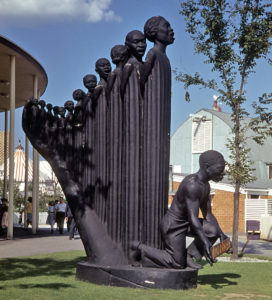Ask A Professor
We’ve created this space for our professors to answer questions submitted to arthistoryfsu on Instagram by our community of students, alumni, and friends.
Our first query comes from a student in response to our Juneteenth post about Augusta Savage’s short-lived monumental sculpture Lift Every Voice and Sing:

Why was the sculpture destroyed? This piece is beautiful!
Dr. Karen Bearor writes:
Lift Every Voice and Sing, commissioned by the New York World’s Fair of 1939, is the largest and most famous sculpture created by Augusta Savage. Yet, until the one artist exhibition of Savage’s work in Augusta Savage: Renaissance Woman at the Cummer Museum of Art in Jacksonville in 2018-2019, relatively few people understood the sculpture’s Florida roots. Fewer still know that Savage briefly attended Florida Agricultural and Mechanical University (FAMU) in Tallahassee.
Born Augusta Christine Fells in Green Cove Springs—on the St. Johns River just south of Jacksonville—in 1892, Augusta grew up in our state. As a child, she made small figures out of the local red clay. Already a mother and widow prior to her marriage to James Savage around 1915, she relocated to West Palm Beach with her family. In 1919, a potter gave her some clay from which she modeled several works. Her sculptures were so impressive that she was allowed to teach a modeling class at the local public school. George Graham Currie, a lawyer and former West Palm Beach mayor, insisted that she be allowed to exhibit some of these sculptures in a local fair in 1919, where she sold some pieces and won a prize. Following this, she moved to Jacksonville for a short period.
It was, of course, in Jacksonville where poet James Weldon Johnson had written “Lift Every Voice and Sing” in 1900 for a Lincoln’s birthday celebration at the Edwin M. Stanton School, then an elementary school serving Black students within the segregated education system of that time. Johnson was principal of the school. In 1905, the poem was set to music written by Johnson’s brother, Rosamond. The song became immensely popular and spread among students throughout the South. In 1919, the NAACP adopted it as the Black National Hymn.
Clutching a letter of recommendation from Currie, Savage soon moved to New York, where she studied at Cooper Union, which did not charge tuition at this time. Through connections, she ended up sculpting a portrait of famed W.E.B. DuBois for the Harlem branch of the New York Public Library. The success of this sculpture led to subsequent busts of Frederick Douglass, Marcus Garvey . . . and James Weldon Johnson, who was appointed first executive secretary of the NAACP in 1920.
During the 1930s, Savage was best known as a teacher in Harlem, first with her own Savage Studio for Arts and Crafts, then as a founder of the Harlem Artists Guild, and subsequently as the director of the Harlem Community Art Center. A number of now-famous artists studied with her. In 1937 she was commissioned by the World’s Fair, as one of only four women artists and as the only Black artist, to create a sculpture. Upon learning in 1938 that her friend James Weldon Johnson had died in an automobile accident, she determined to honor him and the anthem based upon his most famous poem by creating Lift Every Voice and Sing, also known as The Harp.
 Sixteen feet tall at its highest point, the sculpture depicts a choir of twelve figures of graduated heights, the folds in their gowns resembling the strings of the harp. The sounding board of the harp is the arm and hand of God. The shirtless youth kneeling before them holds the foot pedal upon which is depicted the first notes of the hymn—the treble staff notes associated with the words “Lift Every Voice and Sing,” in A-flat major. The sculpture was made of plaster painted black. No patron stepped forth to commission a bronze copy, so this, perhaps the most photographed sculpture at the fair—it even appears in some of the surviving tourist films of the fair compiled online—was destroyed with the close of the fair.
Sixteen feet tall at its highest point, the sculpture depicts a choir of twelve figures of graduated heights, the folds in their gowns resembling the strings of the harp. The sounding board of the harp is the arm and hand of God. The shirtless youth kneeling before them holds the foot pedal upon which is depicted the first notes of the hymn—the treble staff notes associated with the words “Lift Every Voice and Sing,” in A-flat major. The sculpture was made of plaster painted black. No patron stepped forth to commission a bronze copy, so this, perhaps the most photographed sculpture at the fair—it even appears in some of the surviving tourist films of the fair compiled online—was destroyed with the close of the fair.
Following the Cummer exhibition, Glenn Weiss, Jacksonville artist and curator who had managed the Public Art Program for Times Square in New York City, proposed that Jacksonville should honor Savage by making a copy of The Harp to be placed in “Lift Ev’ry Voice and Sing” Park in La Villa, dedicated to the legacy of the Johnson brothers in 2015. The park is now under development; read more here.
Art History graduate students can learn more about Augusta Savage and other Black artists and photographers from the same period in Dr. Bearor’s Spring 2021 graduate seminar on the Harlem Renaissance.
Here is a short YouTube video based on an amateur home movie which gives different “live” angles of the sculpture at the World’s Fair: